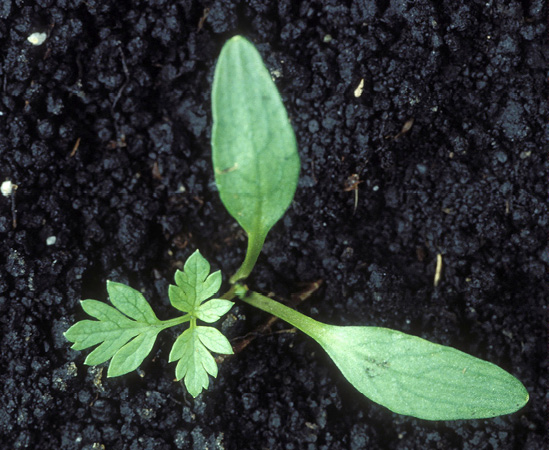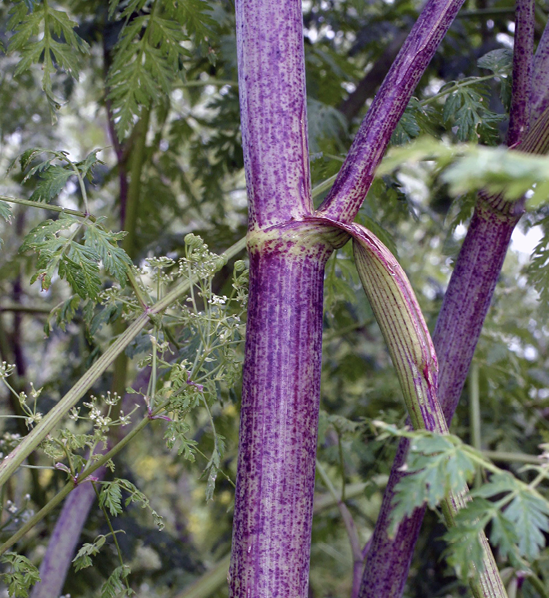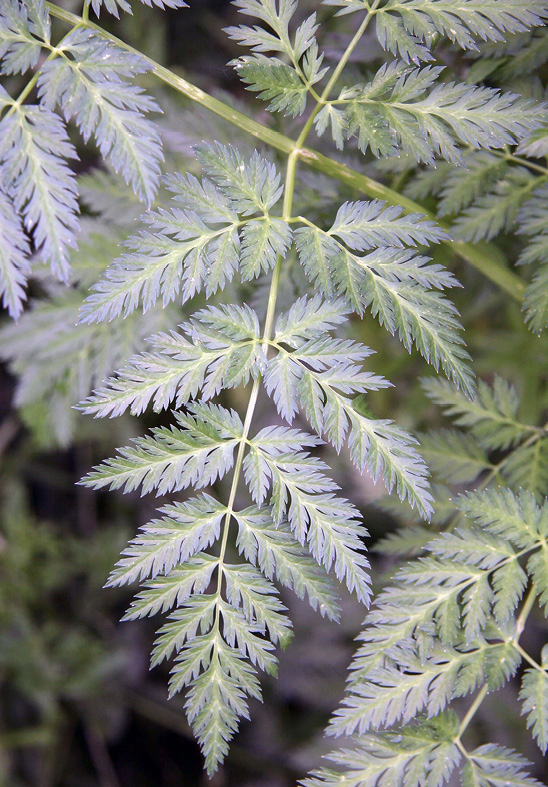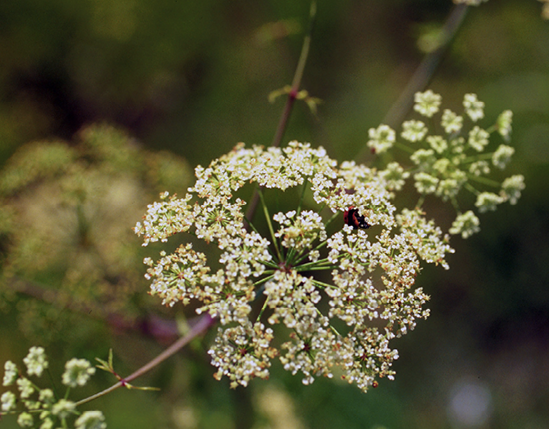Poison Hemlock


Poison hemlock (Conium maculatum L.) is commonly known as deadly hemlock, poison parsley, poison stinkweed, spotted parsley, carrot fern, or snake-weed (Bryson and DeFelice 2009; Mitich 1998; USDA 2016). Native to Eurasia and northern Africa, this herbaceous broadleaf was introduced to the United States as an ornamental garden plant (Mitich 1998; Vetter 2004). Poison hemlock can easily be mistaken for other members of the carrot family (Apiaceae), such as wild carrot (Queen Anne’s Lace), parsley, and turnips (Mitich 1998; Vetter 2004). All parts of this pasture weed are highly toxic and pose a risk to humans and livestock (Bryson and DeFelice 2009; Miller 1980; Mitich 1998; Vetter 2004). The likelihood of hemlock poisoning can be mitigated by better identification and management practices.
Description
Vegetative Growth
This cool-season biennial develops as a basal rosette the first year, followed by the growth of flowering stems the second year (USDA 2016; Vetter 2004). Hairless seedlings feature narrow, lanceolate cotyledons and a pinnately compound first leaf (Figure 1) (Bryson and DeFelice 2009; Vetter 2004). Erect, hollow stems are branched and characterized by a peppering of purple spots (Figure 2) (Bryson and DeFelice 2009; DiTomaso et al. 2013; Miller 1980; Mitich 1998; USDA 2016; Vetter 2004). Lacy leaves (measuring 8 to 16 inches) are triangular, resembling a carrot leaf, and alternate along the plant (Figure 3) (Bryson and DeFelice 2009; DiTomaso et al. 2013; USDA 2016; Vetter 2004). Upper leaves are much smaller than lower leaves (Vetter 2004). Poison hemlock’s long, fleshy taproot is white to pale yellow with projections of lateral secondary roots (DiTomaso et al. 2013; USDA 2016). Mature plants can reach up to 8 feet tall (USDA 2016).
Reproductive Growth
Small, white flowers have five petals and form on the end of rays in umbrella-like clusters, known as an umbel (Figure 4) (Bryson and DeFelice 2009; USDA 2016). These umbels are typically composed of 12 to 16 rays and have four to eight bracts at the base (DiTomaso et al. 2013; Vetter 2004). Poison hemlock reproduces only by seed, with a single plant producing up to 40,000 seeds (USDA 2016; Vetter 2004). Each flower will produce two seeds, measuring around 1/8 inch long (DiTomaso et al. 2013; USDA 2016). These gray-brown, barrel-shaped seeds exhibit five wavy ridges running lengthwise and can remain viable for 3 to 6 years (DiTomaso et al. 2013; Mitich 1998; USDA 2016; Vetter 2004).
Habitat and Distribution
Seeds commonly fall near the mother plant, but they can also be dispersed by birds, rodents, water, and soil-laden vehicles (DiTomaso et al. 2013; Mitich 1998; USDA 2016). Poison hemlock is prevalent across the U.S., where it can be found in every state except Hawaii. It prefers moist, disturbed soil and often grows near hedgerows, roadsides, ditches, waste ground, woodlands, pastures, and banks of streams or rivers (DiTomaso et al. 2013; Mitich 1998; USDA 2016; Vetter 2004). Poison hemlock’s fondness for disturbed areas allows it to occasionally act as a pioneer species (USDA 2016; Vetter 2004).


|
Herbicide |
Instructions for use |
|
2,4-D 2,4-D LV 6 |
Rate: 0.66 to 2.9 pt/acre Timing: Postemergence Remarks: Broadleaf selective. Do not use on alfalfa, bentgrass, clover, other legumes, or newly seeded areas. |
|
Glyphosate Roundup® ProMax |
Rate: 1.3 to 2.7 qt/acre Timing: Postemergence at seedhead initiation Remarks: Nonselective with no residual soil activity. |
|
Aminopyralid + Florpyrauxifen-benzyl TerraVue® |
Rate: 2 to 5.85 oz/acre Timing: Postemergence while actively growing. Remarks: Broadleaf selective. Provides some residual control. Addition of nonionic surfactant recommended. |
|
Imazapic Imazapic 2SL IVM Herbicide |
Rate: 4 to 12 oz/acre Timing: Preemergence and early postemergence Remarks: Postemergence applications should be made before plant reaches 6 inches tall. Use methylated seed oil at 1.5 to 2 pints per acre. |
|
Metsulfuron methyl Escort® XP |
Rate: 1 to 2 oz/acre Timing: Postemergence in the rosette stage Remarks: Addition of surfactant is recommended at 0.25% v/v. Broadleaf forages like alfalfa and clover are very sensitive to this herbicide. |
|
Chlorsulfuron Telar® XP |
Rate: 1 to 2.6 oz/acre Timing: Postemergence in the rosette stage Remarks: Broadleaf selective. Broadleaf forages like alfalfa and clover are very sensitive to this herbicide. Addition of surfactant at 0.25% v/v recommended. |
Toxicity
This plant produces piperidine alkaloids, which primarily act upon the central nervous system, making it highly toxic to both humans and animals (DiTomaso et al. 2013; Mitich 1998; Vetter 2004). Poison hemlock has a pungent odor that deters fresh consumption by most livestock; however, contamination of hay is a major concern (Mitich 1998; USDA 2016; Vetter 2004). Livestock such as cattle, sheep, goats, pigs, and poultry are susceptible to hemlock poisoning (DiTomaso et al. 2013; Mitich 1998; USDA 2016; Vetter 2004). Birth defects are not uncommon in the offspring of livestock that have recovered from this type of poisoning (DiTomaso et al. 2013; Mitich 1998; Vetter 2004).
Due to its strong similarities to other plants within the carrot family, mistaken ingestion is the most common cause of human poisoning (Mitich 1998; USDA 2016; Vetter 2004). Symptoms following ingestion of poison hemlock include trembling, nervousness, difficulty moving, pupal dilation, slow/weak pulse (later becoming rapid), salivation, rapid breathing, frequent urination, nausea, convulsions, and a decrease in body temperature. The most severe cases can result in coma and death due to respiratory failure (DiTomaso et al. 2013; Miller 1980; Mitich 1998; USDA 2016; Vetter 2004).
Contact poison control right away at 1-800-222-1222 if poisoning is suspected.
Control Methods
Poison hemlock’s high seed production, rapid germination rate, and ability to access deeper soil moisture with its taproot make it a competitive weed (USDA 2016). Proper management and control methods are necessary to keep it in check.
Physical Control
Pulling up these weeds by hand can effectively manage small populations if the entire taproot is removed (DiTomaso et al. 2013; USDA 2016). Gloves, pants, and long-sleeve shirts should be worn when dealing with poison hemlock, as contact can cause rashes in some people (USDA 2016). Repeated mowing can prevent seed production but requires frequent observation, as the plant will quickly send up new stalks (DiTomaso et al. 2013; USDA 2016). Tillage provides adequate management of established populations; reseeding with a desirable species is recommended to combat poison hemlock’s tendency to act as a pioneer species (DiTomaso et al. 2013; USDA 2016).
Cultural Control
Always clean vehicles and machinery after working in infested areas to avoid contamination of other fields (USDA 2016). Purchasing certified weed-free seed and hay can reduce the likelihood of accidental livestock poisoning. Additionally, grazing is not a recommended control method due to the plant’s toxicity (DiTomaso et al. 2013). Plant debris should be bagged and then disposed of properly (USDA 2016). Do not burn poison hemlock debris, as smoke emitted can contain toxins (DiTomaso et al. 2013).
Biological Control
There are currently no known effective biological controls for poison hemlock in the United States (DiTomaso et al. 2013; USDA 2016; Vetter 2004).
Chemical Control
The use of herbicides can be an economical method to effectively control large populations of poison hemlock. Repeated application and monitoring will be necessary, as seeds can remain viable for up to 6 years (USDA 2016). Herbicide recommendations for management of poison hemlock in Mississippi are listed in Table 1. This is not a comprehensive list; other trade names and compounds are labeled for this weed. The order of herbicides listed, and trade names used for example purposes, are not reflective of efficacy or preference. Read and understand the product label before application of any herbicide (DiTomaso et al. 2013).
References
Bryson, C. T., and M. S. DeFelice (2009). Weeds of the South. University of Georgia Press
DiTomaso J. M., G. B. Kyser, S. R. Oneto, R. G. Wilson, S. B. Orloff, L. W. Anderson, S. D. Wright, J. A. Roncoroni, T. L. Miller, T. S. Prather, and others (2013). Weed Control in Natural Areas in the Western United States. University of California Weed Research and Information Center
Miller, J. F. (1980). Poisonous Plants of the Southern United States. [The Service]
Mitich L. W. (1998). Poison-Hemlock (Conium maculatum L.). Weed Technology 12:194–197
USDA (2016). Field guide for managing poison hemlock in the Southwest. Albuquerque, New Mexico: United States Department of Agriculture, Forest Service, Southwestern Region. 16 p
Vetter, J. (2004) Poison hemlock (Conium maculatum L.). Food and Chemical Toxicology 42:1373–1382
The information given here is for educational purposes only. References to commercial products, trade names, or suppliers are made with the understanding that no endorsement is implied and that no discrimination against other products or suppliers is intended.
Publication 3919 (POD-06-23)
By Sydney Baker, Graduate Research Assistant, Plant and Soil Sciences; Darrin Dodds, PhD, Professor and Head, Plant and Soil Sciences; and Cori Speights, PhD, Extension Associate I, Biochemistry, Molecular Biology, Entomology, and Plant Pathology.
The Mississippi State University Extension Service is working to ensure all web content is accessible to all users. If you need assistance accessing any of our content, please email the webteam or call 662-325-2262.




